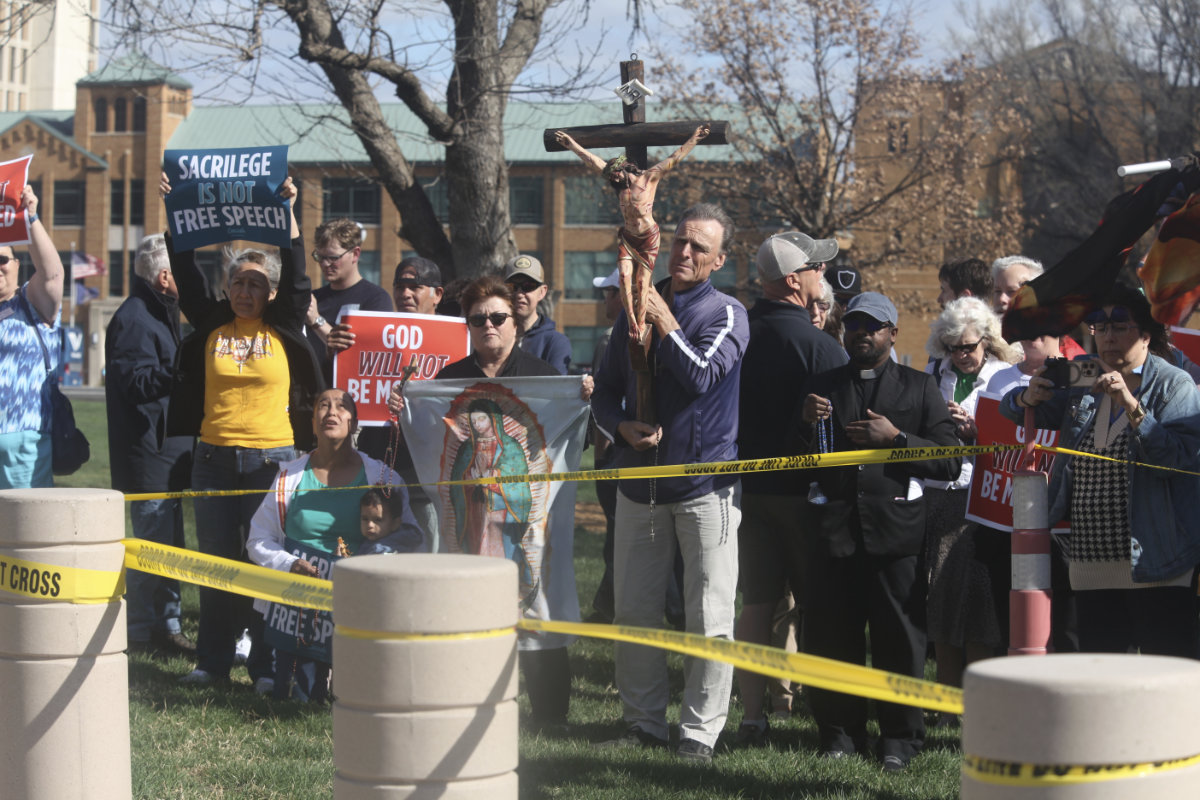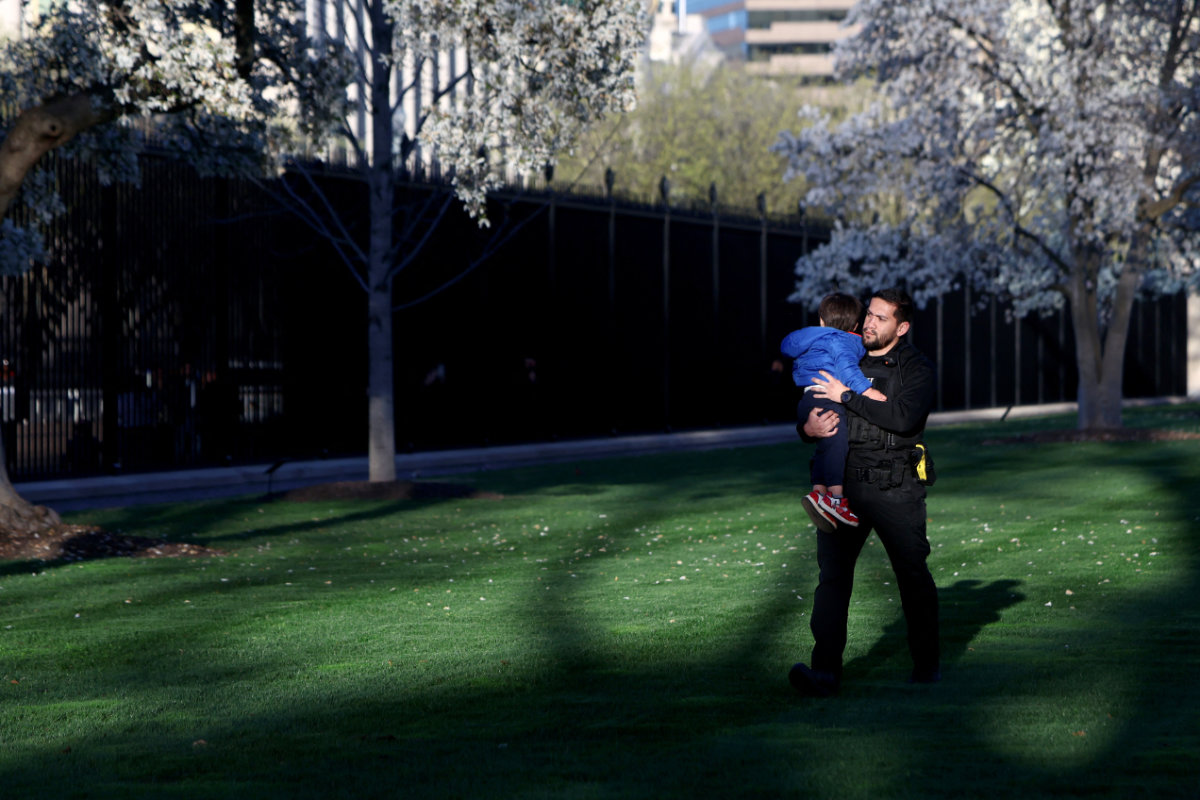TOKYO: A Ugandan weightlifter has been found four days after he disappeared from an Olympic training camp in Japan leaving a note saying he wanted to find work, police said Tuesday.
The disappearance of Julius Ssekitoleko came at a time of high public concern over coronavirus risks as thousands of foreigners arrive for the Games.
“Today, the man was found in Mie Prefecture with no injuries and no involvement in any crime,” an Osaka police official, who declined to be named, told AFP.
“He carried his own ID and identified himself. It is not certain to whom we should send the man — the team or the embassy.”
The alarm was raised on Friday after Ssekitoleko failed to show up for a coronavirus test and was not in his hotel room.
The 20-year-old had recently found out he would not be able to compete at the Tokyo Games, which open on Friday, because of a quota system.
A note was found in his room requesting his belongings be sent to his family in Uganda, according to officials in Izumisano city in Osaka prefecture, where the team were training.
Police said Ssekitoleko had traveled to Nagoya in central Japan and then to nearby Gifu prefecture, before moving south to Mie.
“He was found in a house belonging to people who have a connection to the man. He did not offer resistance. He was talking frankly. We are still questioning him about his motive,” the police official said.
When Uganda’s delegation arrived in Japan last month, a coach tested positive on arrival, with another member of the delegation also testing positive later.
Virus cases are rising in Tokyo, which is under a state of emergency, and there is heavy scrutiny in Japan of infection risks linked to the Games.
Athletes and other Olympic participants are subject to strict rules including regular testing and limits on their movement.
Japan police find Ugandan weightlifter who went missing from Olympic camp
https://arab.news/jxp8s
Japan police find Ugandan weightlifter who went missing from Olympic camp

- Disappearance of Julius Ssekitoleko came at a time of high public concern over coronavirus risks as thousands of foreigners arrive for the Games
Satanist leader’s attempt to hold ‘Black Mass’ inside US statehouse sparks chaos and arrests

- Kansas City-area Satanic Grotto rallied to protested what members called the state’s favoritism toward Christians in allowing events inside the statehouse
- Members of the satanic cult said their rally was in support free speech rights and religious freedoms guaranteed by the US Constitution’s First Amendment
TOPEKA, Kansas: The leader of a small group of self-described satanists and at least one other person were arrested Friday following a scuffle inside the Kansas Statehouse arising from an effort by the group’s leader to start a “Black Mass” in the rotunda.
About 30 members of the Kansas City-area Satanic Grotto, led by its president, Michael Stewart, rallied outside the Statehouse for the separation of church and state. The group also protested what members called the state’s favoritism toward Christians in allowing events inside. Gov. Laura Kelly temporarily banned protests inside, just for Friday, weeks after Stewart’s group scheduled its indoor ceremony.
The Satanic Grotto’s rally outside drew hundreds of Christian counterprotesters because of the Grotto’s satanic imagery, and its indoor ceremony included denouncing Jesus Christ, who Christians believe is the Son of God. About 100 Christians stood against yellow police tape marking the Satanic Grotto’s area. The two groups yelled at each other while the Christians also sang and called on Grotto members to accept Jesus. Several hundred more Christians rallied on the other side of the Grotto’s area, but further away.
Kelly issued her order earlier this month after Roman Catholic groups pushed her to ban any Satanic Grotto event. The state’s Catholic Bishops called what the group planned “a despicable act of anti-Catholic bigotry” mocking the Catholic Mass. Both chambers of the Legislature also approved resolutions condemning it.

“The Bible says Satan comes to steal, kill and destroy, so when we dedicate a state to Satan, we’re dedicating it to death,” said Jeremiah Hicks, a pastor at the Cure Church in Kansas City, Kansas.
Satanic Grotto members, who number several dozen, said they hold a variety of beliefs. Some are atheists, some use the group to protest harm they suffered as church members, and others see Satan as a symbol of independence.
Amy Dorsey, a friend of Stewart’s, said she rallied with the Satanic Grotto to support free speech rights and religious freedoms guaranteed by the US Constitution’s First Amendment, in part because Christian groups are allowed to meet regularly inside the Statehouse for prayer or worship meetings.
Before his arrest, Stewart said his group scheduled its Black Mass for Friday because it thought the Kansas Legislature would be in session, though lawmakers adjourned late Thursday night for their annual spring break. Stewart said the group might come back next year.
“Maybe un-baptisms, right here in the Capitol,” he said.
Video shot by KSNT-TV showed that when Stewart tried to conduct his group’s ceremony in the first-floor rotunda, a young man tried to snatch Stewart’s script from his hands, and Stewart punched him. Several Kansas Highway Patrol troopers wrestled Stewart to the ground and handcuffed him. They led him through hallways on the ground floor below and into a room as he yelled, “Hail, Satan!”
Stewart’s wife, Maenad Bee, told reporters, “He’s only exercising his First Amendment rights.”

Online records showed that Stewart was jailed briefly Friday afternoon on suspicion of disorderly conduct and having an unlawful assembly, then released on $1,000 bond.
Witnesses and friends identified the young man trying to snatch away the script as Marcus Schroeder, who came to counterprotest with fellow members of a Kansas City-area church. Online records show Schroeder was arrested on suspicion of disorderly conduct, with his bond also set at $1,000.
Dorsey said two other Satanic Grotto members also were detained, but didn’t have details. The Highway Patrol did not immediately confirm any arrests or detentions.
A friend of Schroeder’s, Jonathan Storms, said he was trying to help a woman who also sought to snatch away Stewart’s script and “didn’t throw any punches.”
The woman, Karla Delgado, said she came to the Statehouse with her three youngest children to deliver a petition protesting the Black Mass to Kelly’s office. Delgado said she approached Stewart because he was violating the governor’s order and Highway Patrol troopers weren’t immediately arresting him. She said in the ensuing confusion, her 4-year-old daughter was knocked to the ground.
“When we saw that nobody was doing anything — I guess just in the moment of it — it was like, ‘He’s not supposed to be allowed to do this,’ so we tried to stop him,” she said.
Child slips through fencing at White House and is intercepted by Secret Service

- Similar intrusions have happened at th White House before, including in April 2023 when a toddler squeezed through the metal fencing
WASHINGTON: A child slipped through fencing outside the White House on Wednesday and was intercepted by Secret Service officers.
Secret Service spokesperson Anthony Guglielmi said the young trespasser squeezed through the fence on the North Lawn around 6:30 p.m., about an hour after President Donald Trump announced planned auto tariffs from the Oval Office.
“Officers quickly reunited the child with their parents without incident,” Guglielmi said in a social media post.

Video posted on social media shows an armed officer carrying a young child wearing a blue hooded sweatshirt across the lawn before handing off the child to another officer.
Such intrusions have happened before. In April 2023, a toddler squeezed through the metal fencing, also on the North Lawn, and was later reunited with his parents, who were briefly questioned.
It was bacteria — not a miracle — on a communion wafer in US church

- The host, or bread, with red marks had fallen out of a Mass kit at St. Anthony Church in Morris, Indiana
- A biochemical analysis revealed only “fungus and three different species of bacteria, all of which are commonly found on human hands”
MORRIS, Indiana: A laboratory analysis turned up nothing miraculous about red marks found on a Communion wafer at a Catholic church in Indiana.
The discovery at St. Anthony of Padua Catholic Church in Morris was unusual enough for a formal inspection, the Archdiocese of Indianapolis said.
But a biochemical analysis revealed only “fungus and three different species of bacteria, all of which are commonly found on human hands,” the archdiocese said Monday, adding that no blood was found.

The Catholic faith teaches that wine and a bread wafer signify the body and blood of Jesus Christ. Typically, they’re consecrated by a priest at Mass.
The host, or bread, with red marks had fallen out of a Mass kit at St. Anthony Church.
“Throughout the history of the Catholic Church, there have been well-documented miracles and apparitions, and each has been thoroughly and carefully reviewed,” the archdiocese said.
Before the analysis, some members of St. Anthony Church were excited about what might be found.
“We have such a little town. You can drive through and blink and you’re through it,” Shari Strassell, a church member, told WKRC-TV. “It means the world, it does, and I think there is something special about our church up here.”
Japan awards longest-serving death row inmate $1.4 million

- Payout represents 12,500 yen ($83) for each day of the more than four decades that Iwao Hakamada spent in detention
- The former boxer was exonerated last year of a 1966 quadruple murder after a tireless campaign by his sister and others
TOKYO: A Japanese man wrongly convicted of murder who was the world’s longest-serving death row inmate has been awarded $1.4 million in compensation, an official said Tuesday.
The payout represents 12,500 yen ($83) for each day of the more than four decades that Iwao Hakamada spent in detention, most of it on death row when each day could have been his last.
It is a record for compensation of this kind, Japanese media said.
The former boxer, now 89, was exonerated last year of a 1966 quadruple murder after a tireless campaign by his sister and others.
The case sparked scrutiny of the justice system in Japan, where gaining a retrial is notoriously hard and death row inmates are often informed of their impending death just a few hours before they are hanged.
The Shizuoka District Court, in a decision dated Monday, said that “the claimant shall be granted 217,362,500 yen ($1.44 million),” a court spokesman told AFP.
The same court ruled in September that Hakamada was not guilty in a retrial and that police had tampered with evidence.
Hakamada had suffered “inhumane interrogations meant to force a statement (confession)” that he later withdrew, the court said at the time.
Hakamada’s legal team said the money falls short of the pain he suffered between his 1966 arrest and his release in 2014, when he was granted a retrial.
“I think the fact that he will receive it... compensates him a little bit for all the hardship,” lawyer Hideyo Ogawa told a press conference.
“But in light of the hardship and suffering of the past 47 or 48 years, and given his current situation, I think it shows that the state has made mistakes that cannot be atoned for with 200 million yen,” he said.
Decades of detention – with the threat of execution constantly looming – took a major toll on Hakamada’s mental health, his lawyers have said, describing him as “living in a world of fantasy.”
Hakamada was convicted of robbing and killing his boss, the man’s wife and their two teenage children.
He initially denied the charges but police said Hakamada eventually confessed.
During his trial, Hakamada claimed innocence, saying that his confession was forced.
More than a year after the killings, investigators said they found blood-stained clothes – a key piece of evidence that the court later said was planted by investigators.
Hakamada now lives with his sister with help from supporters.
Hakamada was the fifth death row inmate granted a retrial in Japan’s post-war history. All four previous cases also resulted in exonerations.
Japan is the only major industrialized democracy other than the United States to retain capital punishment, a policy that has broad public support.
Japan’s justice minister said in October that abolishing the death penalty would be “inappropriate” even after Hakamada’s acquittal.
Stressed? Sick? Swiss town lets doctors prescribe free museum visits as art therapy for patients

- Dr. Marc-Olivier Sauvain, head of surgery at the Neuchatel Hospital Network, said he had already prescribed museum visits to two patients to help them get in better shape before a planned operation
NEUCHATEL, Switzerland: The world’s woes got you down? Feeling burnout at work? Need a little something extra to fight illness or prep for surgery? The Swiss town of Neuchâtel is offering its residents a novel medical option: Expose yourself to art and get a doctor’s note to do it for free.
Under a new two-year pilot project, local and regional authorities are covering the costs of “museum prescriptions” issued by doctors who believe their patients could benefit from visits to any of the town’s four museums as part of their treatment.
The project is based on a 2019 World Health Organization report that found the arts can boost mental health, reduce the impact of trauma and lower the risk of cognitive decline, frailty and “premature mortality,” among other upsides.
Art can help relax the mind — as a sort of preventative medicine — and visits to museums require getting up and out of the house with physical activity like walking and standing for long periods.
Neuchatel council member Julie Courcier Delafontaine said the COVID crisis also played a role in the program’s genesis. “With the closure of cultural sites (during coronavirus lockdowns), people realized just how much we need them to feel better.”
She said so far some 500 prescriptions have been distributed to doctors around town and the program costs “very little.” Ten thousand Swiss francs (about $11,300) have been budgeted for it.
If successful, local officials could expand the program to other artistic activities like theater or dance, Courcier Delafontaine said. The Swiss national health care system doesn’t cover “culture as a means of therapy,” but she hopes it might one day, if the results are positive enough.
Marianne de Reynier Nevsky, the cultural mediation manager in the town of 46,000 who helped devise the program, said it built on a similar idea rolled out at the Fine Arts Museum in Montreal, Canada, in 2019.
She said many types of patients could benefit.
“It could be a person with depression, a person who has trouble walking, a person with a chronic illness,” she said near a display of a feather headdress from Papua New Guinea at the Ethnographic Museum of Neuchatel, a converted former villa that overlooks Late Neuchatel.
Part of the idea is to get recalcitrant patients out of the house and walking more.
Dr. Marc-Olivier Sauvain, head of surgery at the Neuchatel Hospital Network, said he had already prescribed museum visits to two patients to help them get in better shape before a planned operation.
He said a wider rollout is planned once a control group is set up. For his practice, the focus will be on patients who admit that they’ve lost the habit of going out. He wants them to get moving.
“It’s wishful thinking to think that telling them to go walk or go for a stroll to improve their fitness level before surgery” will work, Sauvain said on a video call Saturday, wearing blue scrubs. “I think that these patients will fully benefit from museum prescriptions. We’ll give them a chance to get physical and intellectual exercise.”
“And as a doctor, it’s really nice to prescribe museum visits rather than medicines or tests that patients don’t enjoy,” he added. “To tell them ‘It’s a medical order that instructs you to go visit one of our nice city museums.’”
Some museum-goers see the upsides too.
“I think it’s a great idea,” said Carla Fragniere Filliger, a poet and retired teacher, during a visit to the ethnography museum. “There should be prescriptions for all the museums in the world!”






















